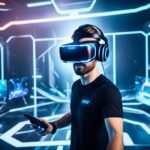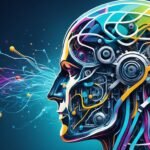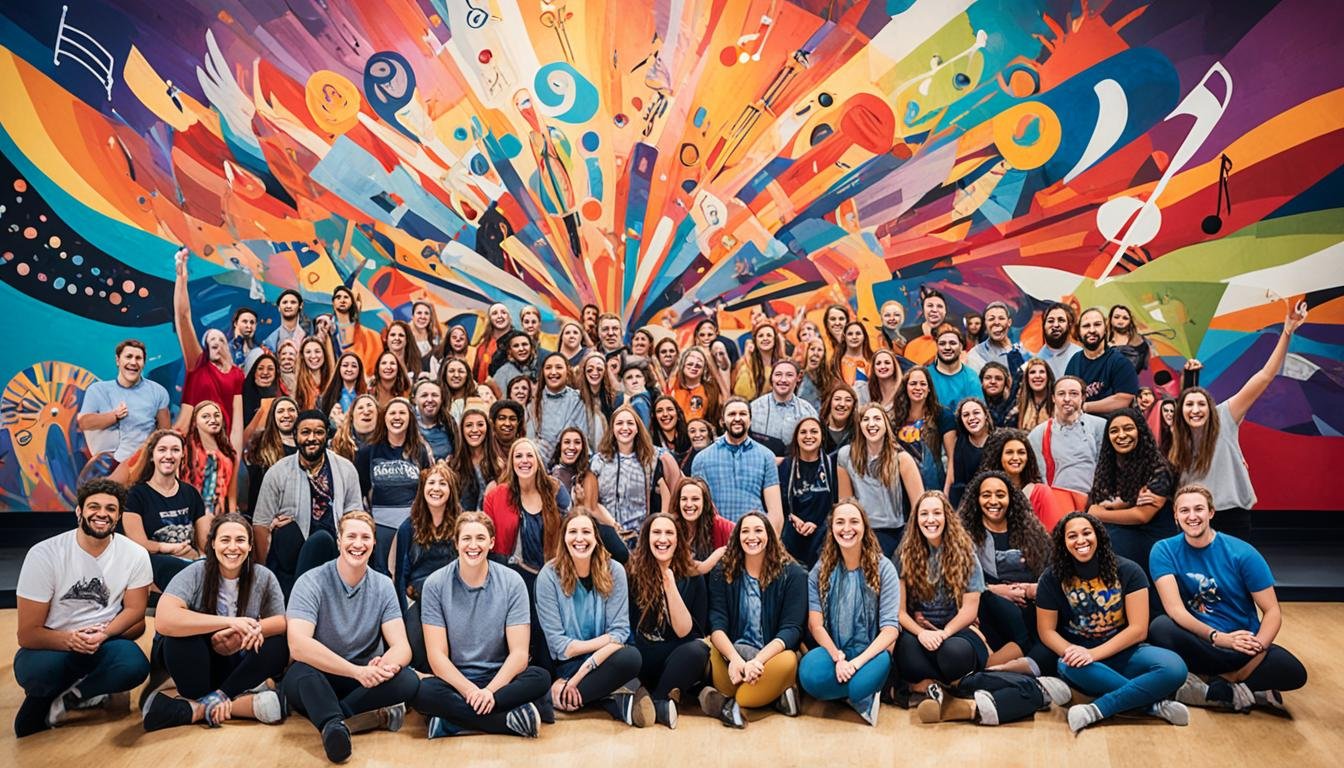Technology has always played a significant role in shaping education, and the ever-evolving field of educational technology continues to revolutionize teaching and learning. From cutting-edge digital tools to innovative e-learning solutions, the advancements in education technology are transforming traditional classroom practices and offering new possibilities for educators and students alike.
In this article, I will explore the latest trends and innovations in education technology and their potential to enrich the learning experience. We will delve into the use of digital tools in education, the integration of AI and virtual reality in the classroom, as well as the emergence of breakthrough educational software. Join me on this journey to discover how the new wave of educational technology is revolutionizing education and preparing students for the future.
Key Takeaways:
- Innovations in education technology are transforming teaching and learning.
- Digital tools are reshaping the classroom experience and enhancing student engagement.
- AI and virtual reality are revolutionizing how students learn and explore complex concepts.
- Breakthrough educational software is providing personalized and interactive learning experiences.
- The new wave of educational technology is preparing students for the future by equipping them with essential digital skills.
The Evolution from Chalkboards to Digital Boards
Classrooms have come a long way from the days of chalkboards and dusty erasers. Throughout history, educators have embraced various tools and technologies to enhance the learning experience. The transition from traditional chalkboards to modern digital boards has been a significant milestone in the evolution of classroom technology.
A Glimpse into Classroom History
In the past, classrooms were equipped with simple chalkboards, where teachers would write lessons and equations for students to copy. While effective at the time, this traditional teaching method had limitations in terms of interactivity and engagement.
However, as technology advanced, educators recognized the need for more dynamic and interactive teaching tools to keep up with the changing needs of students. This led to the introduction of interactive whiteboards and digital cameras.
The Role of Interactive Whiteboards and Digital Cameras in Modern Education
Interactive whiteboards have revolutionized the modern classroom by providing educators with a platform to create engaging and interactive lessons. These whiteboards allow teachers to incorporate multimedia elements, such as images, videos, and interactive activities, into their presentations. Students can actively participate in the learning process by interacting directly with the whiteboard, making learning more hands-on and immersive.
Digital cameras have also played a crucial role in modern education. They enable students to capture images and videos, allowing for multimedia learning experiences. Students can document their experiments, field trips, and projects, enhancing their understanding of the subject matter while fostering creativity and collaboration.
The integration of interactive whiteboards and digital cameras has transformed the classroom into a modern learning environment that promotes active engagement, critical thinking, and creativity.
| Traditional Chalkboards | Digital Boards |
|---|---|
| Passive learning | Interactive and engaging |
| Limited multimedia integration | Incorporates images, videos, and interactive activities |
| Static teaching materials | Dynamic and customizable teaching materials |
| One-way communication | Promotes collaboration and student participation |
Empowering Education through Personal Computers and the Internet
Personal computers and the internet have revolutionized education, empowering both students and educators. The widespread accessibility of personal computers and the internet has opened up new avenues for e-learning and online education, transforming the traditional classroom experience.
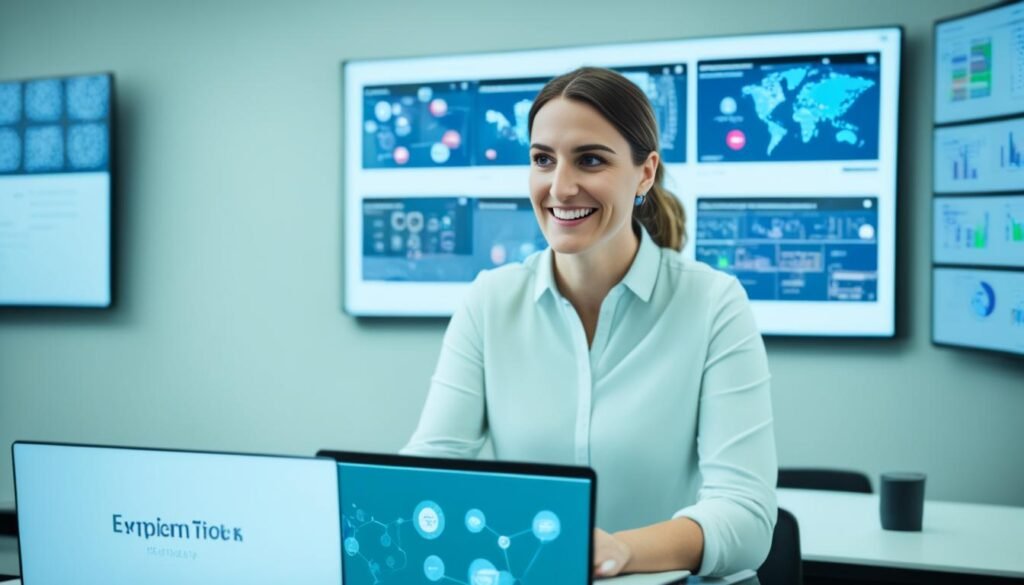
Students now have the ability to access a vast array of digital resources, educational software, and online courses to enhance their learning experience. With just a few clicks, they can delve into a wealth of knowledge and explore subjects in depth. Online education has made learning more inclusive and flexible, allowing students to pursue education at their own pace and on their own terms.
For educators, the internet has become an invaluable tool. They can deliver personalized instruction to students, tailoring lessons to individual needs and learning styles. The internet enables collaboration with other professionals, fostering a global community of educators who can share resources and experiences. With online platforms and tools, educators can access a wealth of digital teaching materials and incorporate multimedia elements into their lessons, making the learning experience more engaging and interactive.
In addition to e-learning and teaching resources, the internet provides a platform for online discussions and forums where students can collaborate with peers from around the world. Interacting with students from diverse backgrounds fosters cultural understanding and promotes global citizenship. The internet also facilitates communication between students and teachers, allowing for quick feedback and clarifications.
The combination of personal computers and the internet has transformed education into a dynamic and student-centered environment. With these powerful tools at their disposal, students and educators can unleash their full potential and explore new frontiers in learning.
| Benefits of Personal Computers and the Internet in Education | Examples |
|---|---|
| Access to Digital Resources | Online libraries, educational websites, and digital textbooks. |
| E-learning Opportunities | Online courses, virtual classrooms, and educational apps. |
| Personalized Instruction | Adaptive learning platforms and personalized learning pathways. |
| Global Collaboration | Online forums, video conferences, and collaborative projects. |
| Flexible Learning Environment | Anywhere, anytime access to educational materials and resources. |
| Engaging Multimedia Content | Interactive videos, animations, and simulations. |
Blending Traditional Learning with Cutting-Edge Edtech Solutions
The Proliferation of Portable Devices in Education
The integration of cutting-edge edtech solutions into traditional learning methods has opened up new possibilities for educational experiences. One significant development is the proliferation of portable devices in education, such as laptops, tablets, and smartphones. These devices have revolutionized the way students access and consume educational content, providing them with anytime, anywhere learning opportunities.
Portable devices offer students the flexibility to learn at their own pace, whether they are in a classroom, library, or even at home. With educational apps, e-books, and online resources available at their fingertips, students can engage in interactive and personalized learning experiences. These devices also enable educators to deliver content in diverse formats, catering to different learning styles and preferences.
Social Media: An Emerging Educational Tool
Social media platforms have emerged as valuable educational tools, facilitating collaboration, knowledge sharing, and communication among students and educators. With the increasing integration of social media into educational settings, students can engage in meaningful discussions, share resources, and collaborate on projects in virtual environments.
Through social media, students can connect with peers from around the globe, expand their perspectives, and enhance their digital literacy skills. Educators can leverage social media platforms to facilitate discussions, provide instant feedback, and create engaging learning communities.
The combination of portable devices and social media has paved the way for blended learning approaches, where traditional classroom settings are complemented by digital tools and online resources. This integration promotes active participation, student-centered learning, and fosters critical thinking skills.
Virtual Reality and Augmented Reality: A New Dimension in Education
Virtual reality (VR) and augmented reality (AR) have introduced a new dimension to education, combining interactivity with immersion. VR technology allows students to experience virtual environments, simulating real-world scenarios and enhancing the understanding of complex concepts. AR technology overlays digital information onto the real world, providing interactive experiences and augmenting the learning process.
Interactivity Meets Immersion
With virtual reality, students are not just passive recipients of information but active participants in the learning process. They can explore virtual environments, manipulate objects, and engage in realistic simulations, which foster deeper understanding and critical thinking skills. The interactive nature of VR makes learning engaging and captivating, as students become fully immersed in the virtual world.
To illustrate the impact of VR on education, consider a science class where students can virtually dissect a frog. Instead of observing diagrams or videos, they can use virtual tools to perform the dissection themselves, gaining hands-on experience and a better understanding of anatomy. This interactive and immersive learning experience enhances engagement, retention, and overall knowledge acquisition.
The Potential of AR Glasses in Future Learning Environments
While VR offers a completely virtual experience, augmented reality is poised to transform physical learning environments. AR glasses, such as Microsoft’s HoloLens or Apple’s rumored smart glasses, have the potential to seamlessly integrate digital content into the physical world. These glasses can overlay interactive virtual information onto real-world objects, enabling students to interact with the environment in innovative ways.
Imagine a history lesson where students can wear AR glasses and see historical events unfold before their eyes. They can walk through ancient ruins, witness pivotal moments, and interact with historical figures—all while seeing digital overlays that provide additional context and information. AR glasses have the potential to revolutionize field trips, museum visits, and other educational experiences by bringing learning to life in a visually immersive and interactive manner.
Moreover, AR glasses can personalize the learning experience by adapting content to individual students’ needs. They can provide real-time feedback, offer additional resources, and tailor the level of difficulty to match each student’s abilities. This level of customization has the potential to enhance student engagement and optimize learning outcomes.
| Benefits of VR and AR in Education | VR | AR |
|---|---|---|
| Enhanced understanding of complex concepts | ✔ | ✔ |
| Increased engagement and motivation | ✔ | ✔ |
| Interactive and immersive learning experiences | ✔ | ✔ |
| Personalized learning and adaptive content | ✘ | ✔ |
| Integration with real-world environments | ✘ | ✔ |
As technology continues to advance, virtual reality and augmented reality hold immense potential to transform the way students learn and engage with educational materials. By combining interactivity and immersion, these technologies offer a unique and captivating learning experience that can revolutionize traditional teaching methods. As educators and learners embrace the power of VR and AR, we can expect future learning environments to be more dynamic, interactive, and personalized than ever before.
Innovations in Education Technology
The field of education technology is constantly evolving, with new innovations and advancements being introduced regularly. From AI-powered learning platforms to adaptive learning systems, these innovations are revolutionizing the way education is delivered. Cutting-edge tools and transformative solutions are reshaping the classroom experience, enhancing student engagement, and improving learning outcomes.
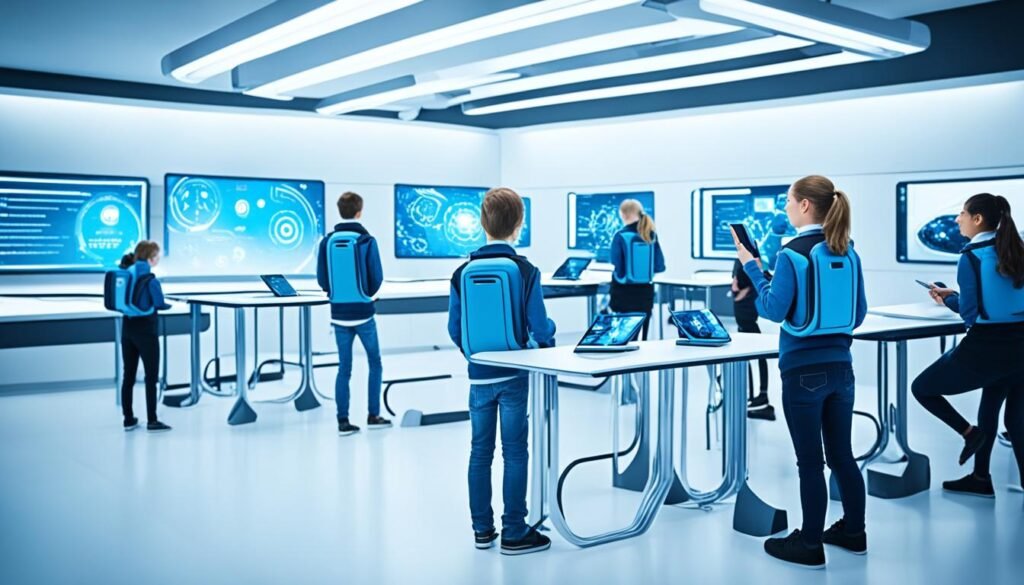
One of the key advancements in education technology is the development of AI-powered learning platforms. These platforms utilize artificial intelligence algorithms to personalize the learning experience for each student, providing tailored recommendations and adaptive content. By analyzing vast amounts of data, AI-powered platforms can identify individual learning needs and adapt teaching methods accordingly, leading to more effective and efficient learning.
Another innovative solution in education technology is the integration of virtual and augmented reality. VR and AR technologies offer immersive and interactive learning experiences, allowing students to explore virtual environments, manipulate objects, and engage with complex concepts in a more hands-on way. These technologies provide a unique and engaging learning experience that enhances understanding and retention.
Moreover, the rise of digital assessment and feedback tools has transformed the way educators evaluate student progress. With the help of educational software and intelligent systems, teachers can create online quizzes, assignments, and exams that provide immediate feedback and personalized recommendations. This real-time feedback enables students to track their progress, identify areas for improvement, and take ownership of their learning.
The continuous advancements in education technology are transforming the traditional classroom into a dynamic and interactive learning environment. As educators embrace these cutting-edge tools and transformative solutions, they can create engaging and personalized learning experiences that cater to the diverse needs of students. By harnessing the power of educational technology innovations, the future of education holds immense potential for enhancing student outcomes and empowering learners.
Tailoring Pedagogy with Adaptive Learning and AI
Adaptive learning and artificial intelligence (AI) are revolutionizing pedagogy by personalizing the learning journey for each student. Through the power of AI-powered algorithms, adaptive learning systems can analyze vast amounts of student data and create personalized learning paths that cater to individual strengths and weaknesses. This tailored approach ensures that students receive instruction and resources that align with their unique needs, enhancing their engagement and understanding.
AI also plays a pivotal role in assessment and feedback, improving the accuracy and timeliness of evaluating student progress. Intelligent systems powered by AI can provide immediate feedback to students, pinpoint areas of improvement, and offer targeted interventions to support their learning. This targeted feedback and guidance enable students to develop a deeper understanding of concepts and make meaningful progress in their educational journey.
The integration of adaptive learning and AI in the classroom has the potential to transform teaching methods and improve learning outcomes. By leveraging the power of intelligent systems and personalized instruction, educators can create a more dynamic and student-centered learning environment. Adaptive learning and AI empower educators to address the diverse needs of their students and foster a culture of continuous improvement.
As education continues to evolve, it’s essential for educators to embrace the opportunities offered by adaptive learning and AI. By leveraging these technologies, educators can unlock the full potential of their students and provide them with a tailored, engaging, and effective learning experience. The future of education lies in the seamless integration of adaptive learning and AI, enabling students to thrive in an ever-changing world.
The Significance of Biometrics and Emotional Analytics in Learning
Biometrics and emotional analytics are emerging technologies that hold great significance in the field of education.
Biometrics, such as facial recognition and fingerprint scanning, can be used to identify students and track their attendance, providing a more streamlined and secure learning environment.
Emotional analytics, on the other hand, analyze students’ emotional states and well-being to provide personalized feedback and support. By understanding students’ emotional responses, educators can better tailor instruction and create a positive learning environment.
These technologies have the potential to enhance the overall learning experience and promote student well-being.

Fostering Global Collaboration with Multi-Touch Surfaces
Multi-touch surfaces, such as interactive desks and workstations, are revolutionizing education by fostering global collaboration and transforming the way students interact and learn. These innovative technologies empower students to work together on shared projects, regardless of their physical location.
From isolated desks to connected workstations, students can now collaborate with their peers around the world, breaking down cultural barriers and exchanging ideas. This global collaboration promotes a sense of global citizenship, encouraging students to engage with diverse perspectives in a rapidly globalizing world.
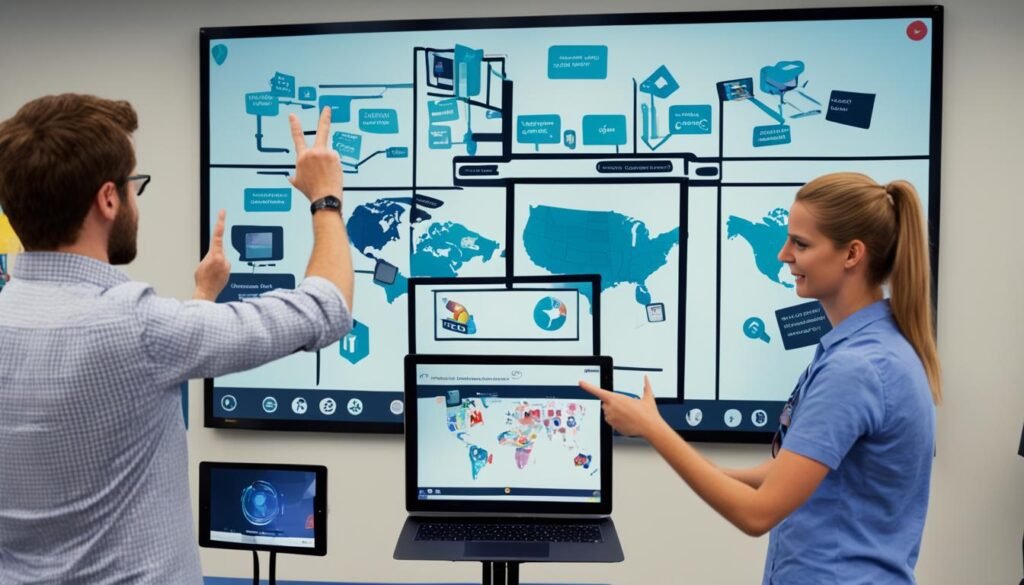
From Isolated Desks to Connected Workstations
The traditional classroom setup, with individual desks and limited interaction, is giving way to a new era of connected workstations. Multi-touch surfaces enable students to engage in collaborative activities and virtual teamwork, providing them with the skills and experiences necessary for success in the modern workforce.
By working together on interactive displays, students can brainstorm ideas, solve problems, and create innovative solutions. These collaborative workstations promote teamwork, communication, and critical thinking skills, preparing students for the interconnected nature of the professional world.
Encouraging Worldwide Student Engagement
Multi-touch surfaces not only facilitate collaboration but also foster active student engagement on a global scale. By leveraging these technologies, educators can create interactive learning experiences that captivate students’ attention and enhance their understanding of complex concepts.
Through virtual classrooms and online platforms, students can participate in real-time discussions, join international projects, and engage with diverse communities of learners. This exposure to different perspectives and cultures enriches their learning journey and prepares them to become global citizens.
Collaborative learning experiences facilitated by multi-touch surfaces are reshaping the education landscape, promoting cross-cultural understanding, and equipping students with the skills they need to thrive in an interconnected world.
Conclusion
The Future Trajectory of Educational Practices
In conclusion, the future of education is being shaped by the new wave of educational technology. The innovative solutions offered by these advancements have the potential to revolutionize the traditional methods of teaching and learning. As technology continues to advance at a rapid pace, it is crucial for educators to stay ahead and embrace these technological advancements.
Staying Ahead: The Educator’s Guide to Technological Advancements
Educators play a vital role in preparing students for a rapidly changing world. To leverage the full potential of technological advancements, educators need to stay informed and adapt their teaching practices accordingly. By staying ahead, educators can ensure that they are equipped with the knowledge and skills necessary to create engaging and effective learning experiences for their students.
Technological advancements in education offer exciting opportunities for personalized learning, collaborative projects, and interactive experiences. By embracing these advancements, educators can foster a dynamic learning environment that promotes student engagement and prepares students for the challenges and opportunities of the future.
